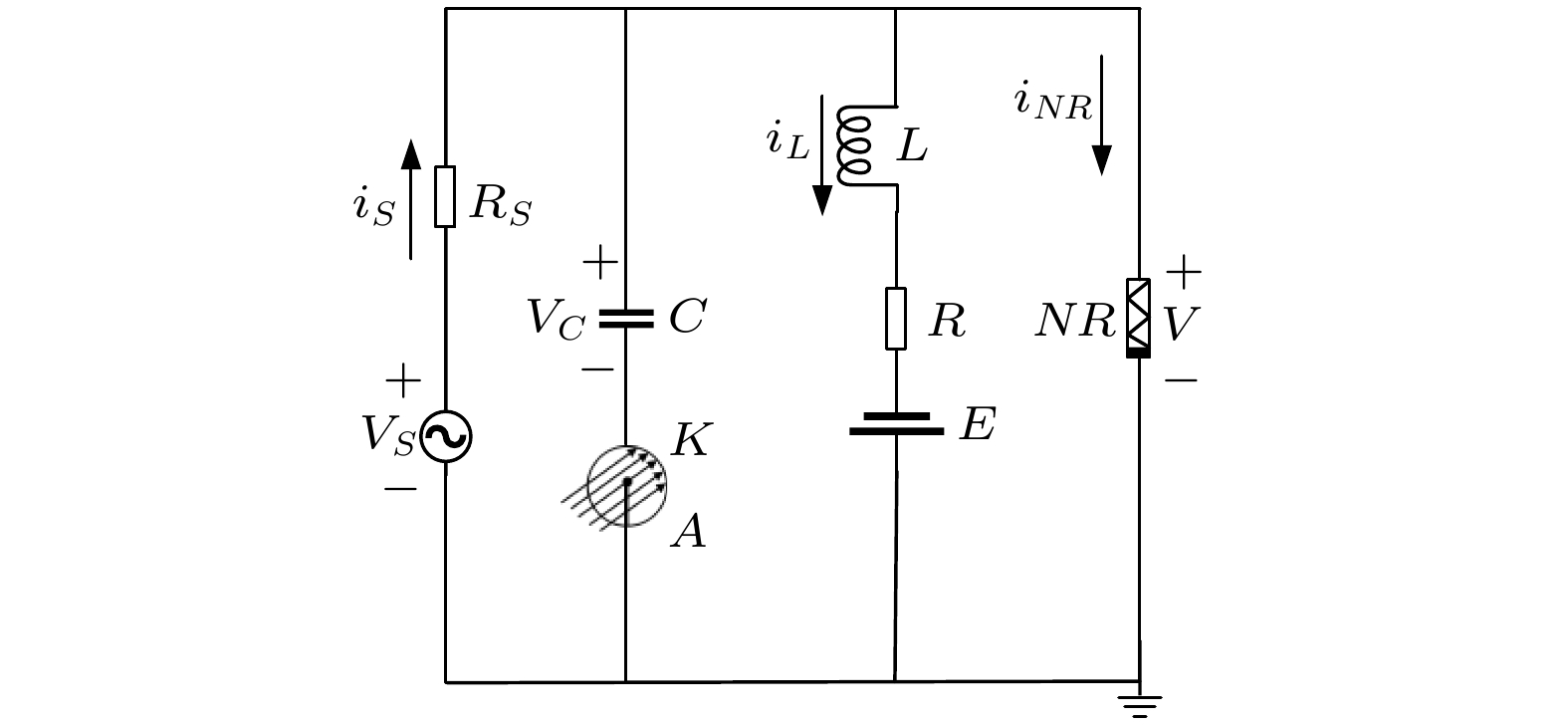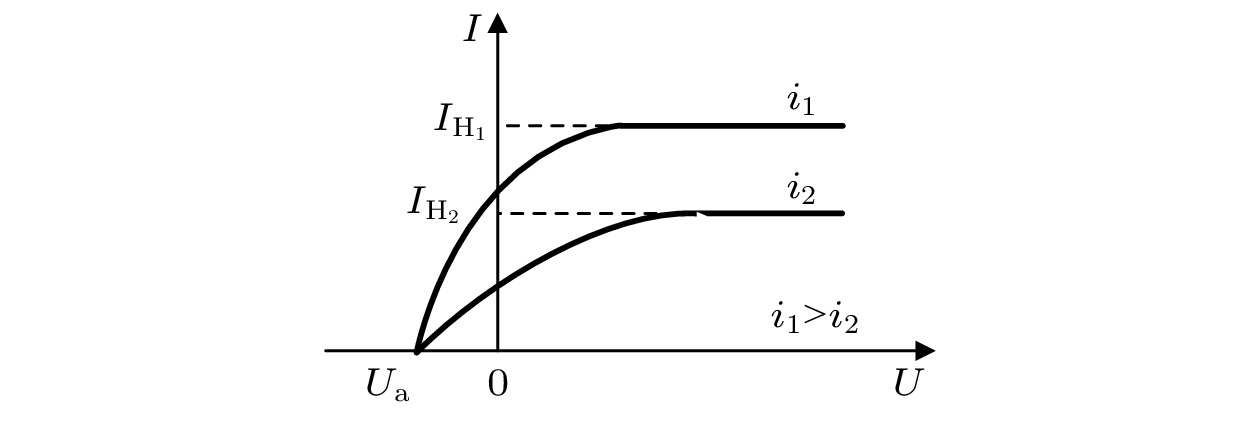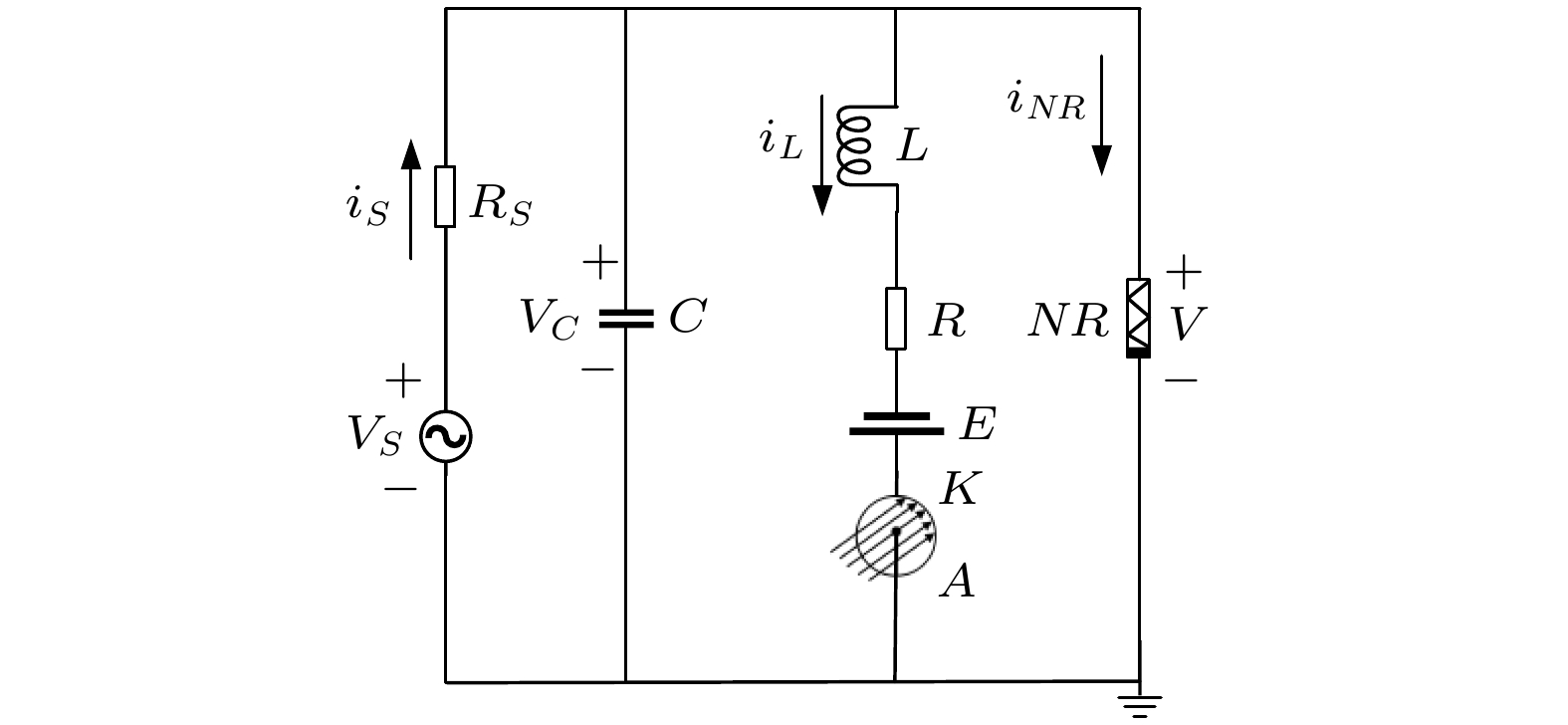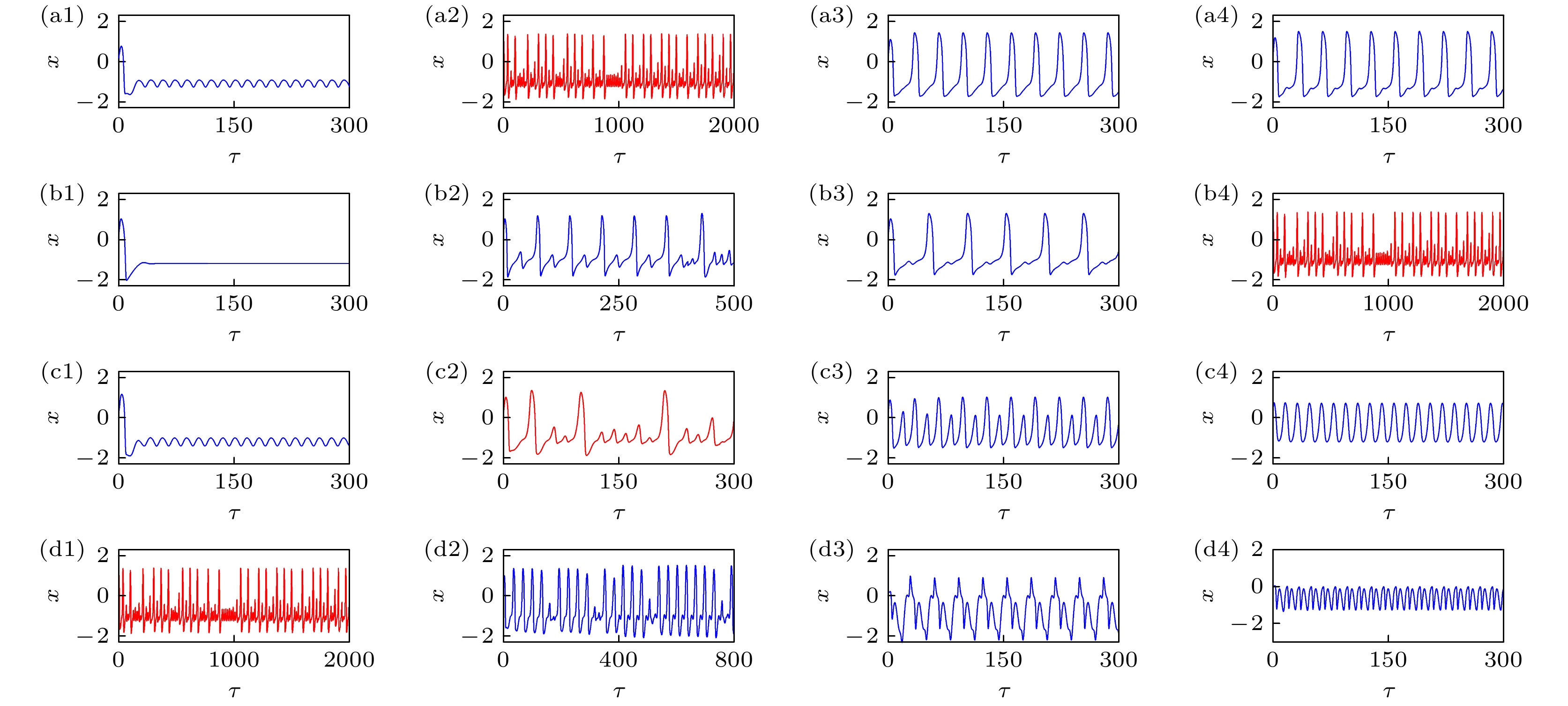-
放电模态是可以识别生物神经元的电活动, 即细胞内和细胞外的离子被泵送并在细胞内交换的过程. 通过适当的物理刺激, 人工神经元电路可以被设计以重现类似生物神经元的放电模式. 光电管中产生的光电流可以作为信号源, 对神经元电路进行刺激. 但由于不同支路上的通道电流对功能神经元动力学的控制程度不同, 所以光电管接入不同的支路, 将会使神经元电路的放电模式产生很大差异. 本文所采用的非线性神经元是由一个电容器、感应线圈、非线性电阻、两个理想电阻和一个周期电压源组成的FHN (FitzHugh-Nagumo neuron)电路. 在此基础上, 将光电管引入不同的支路来改变通道电流, 以研究光电流的生物物理作用. 当光电管连接到电容上, 光电管被激活从而改变通道电流时, 细胞膜电位可以直接改变, 并切换激发模式. 当光电管串联连接到感应线圈时, 通过感应线圈的感应电流被调节以平衡外部刺激. 这些结果表明, 在本文构建的两类光敏神经元模型中, 相比光电流驱动电感支路, 光电流驱动电容器支路可以更有效地调节膜电位, 大大提高感光灵敏度.Firing patterns discern the electrical activities in biological neurons when intracellular and extracellular ions are pumped into cells and exchanged there. Artificial neural circuits can be tamed to reproduce similar firing modes from biological neurons by applying appropriate physical stimuli. Photocurrent generated in the phototube can be used as a signal source, which can stimulate the neural circuits, while the involvement of which branch circuit will be much different because the channel current can control the dynamics of functional neuron to a different degree. In this paper, based on a nonlinear (FitzHugh-Nagumo, FHN) neural circuit composed of one capacitor, induction coil, nonlinear resistor, two ideal resistors and one periodical stimulus, the phototube is incorporated into different branch circuits for changing the channel current and the biophysical role of photocurrent is investigated. The dynamical equations of three types of system are unified, though they fall in different areas in parameter space. The membrane potential can be directly changed and firing modes are switched when photocurrent is activated to change the channel current by connecting the phototube to the capacitor. The induced current across the induction coil is regulated to balance the external stimulus when the phototube is connected to the induction coil in series. The two types of photosensitive neuron models constructed in this paper are compared with the photocurrent driven inductive branch showing that the photocurrent driven capacitive branch can very effectively regulate the membrane potential and greatly improve the photosensitive sensitivity.
-
Keywords:
- neural circuit /
- phototube /
- bifurcation /
- functional neuron
[1] Torres J J, Elices I, Marro J 2015 Plos One 10 E0121156
 Google Scholar
Google Scholar
[2] Belykh I, De Lange E, Hasler M 2005 Phys. Rev. Lett. 94 188101
 Google Scholar
Google Scholar
[3] Wig G S, Schlaggar B L, Petersen S E 2011 Ann. Ny. Acad. Sci. 1224 126
 Google Scholar
Google Scholar
[4] Izhikevich E M 2004 IEEE T. Neural. Networ. 15 1063
 Google Scholar
Google Scholar
[5] Ozer M, Ekmekci N H 2005 Phys. Lett. A 338 150
 Google Scholar
Google Scholar
[6] Bao B C, Liu Z, Xu J P 2010 Electron Lett. 46 237
 Google Scholar
Google Scholar
[7] Li Q, Zeng H, Li J 2015 Nonlinear Dynam. 79 2295
 Google Scholar
Google Scholar
[8] Song X, Wang C, Ma J, Tang J 2015 Sci. China Technol. Sci. 58 1007
 Google Scholar
Google Scholar
[9] Lin W, Wang Y, Ying H, Lai Y C, Wang X 2015 Phys. Rev. E 92 012912
 Google Scholar
Google Scholar
[10] Ren G, Tang J, Ma J, Xu Y 2015 Commun. Nonlinear Sci. 29 170
 Google Scholar
Google Scholar
[11] Perc M, Marhl M 2005 Phys. Rev. E 71 026229
 Google Scholar
Google Scholar
[12] Perc M 2007 Chaos Soliton Fract. 32 1118
 Google Scholar
Google Scholar
[13] Takembo C N, Fouda H P E 2020 Sci. Rep. 10 1
 Google Scholar
Google Scholar
[14] Sharp A A, O'neil M B, Abbott L, Marder E 1993 Trends Neurosci. 16 389
 Google Scholar
Google Scholar
[15] Ma J, Zhang G, Hayat T, Ren G 2019 Nonlinear Dynam. 95 1585
 Google Scholar
Google Scholar
[16] Rocha R, Ruthiramoorthy J, Kathamuthu T 2017 Nonlinear Dynam. 88 2577
 Google Scholar
Google Scholar
[17] Binczak S, Jacquir S, Bilbault J-M, Kazantsev V B, Nekorkin V I 2006 Neural Networks 19 684
 Google Scholar
Google Scholar
[18] Cosp J, Binczak S, Madrenas J, Fernández D 2008 IEEE International Symposium On Circuits And Systems Seattle, WA, USA, May18–21, 2008 pp2370−2373
[19] Wang C, Chu R, Ma J 2015 Complexity 21 370
 Google Scholar
Google Scholar
[20] Volos C, Akgul A, Pham V T, Stouboulos I, Kyprianidis I 2017 Nonlinear Dynam. 89 1047
 Google Scholar
Google Scholar
[21] Ma J, Yang Z Q, Yang L J, Tang J 2019 J Zhejiang Univ. Sci A 20 639
 Google Scholar
Google Scholar
[22] Karthikeyan A, Cimen M E, Akgul A, Boz A F, Rajagopal K 2021 Nonlinear Dynam. 103 1979
 Google Scholar
Google Scholar
[23] Zhang S, Zheng J, Wang X, Zeng Z 2021 Chaos 31 011101
 Google Scholar
Google Scholar
[24] Sahin M, Taskiran Z C, Guler H, Hamamci S 2019 Sensor Actuat A 290 107
 Google Scholar
Google Scholar
[25] Ren G, Zhou P, Ma J, Cai N, Alsaedi A, Ahmad B 2017 Int. J. Bifurcat Chaos 27 1750187
 Google Scholar
Google Scholar
[26] Wang C, Liu Z, Hobiny A, Xu W, Ma J 2020 Chaos Soliton Fract. 134 109697
 Google Scholar
Google Scholar
[27] Hindmarsh J L, Rose R 1984 Proc. Roy. Soc. Lond. B: Bio. Sci. 221 87
 Google Scholar
Google Scholar
[28] Cao H, Wu Y 2013 Int. J. Bifurcat Chaos 23 1330041
 Google Scholar
Google Scholar
[29] Tanaka G, Ibarz B, Sanjuan M A, Aihara K 2006 Chaos 16 013113
 Google Scholar
Google Scholar
[30] Zhang J, Huang S, Pang S, Wang M, Gao S 2016 Nonlinear Dynam. 84 1303
 Google Scholar
Google Scholar
[31] Usha K, Subha P 2019 Chin. Phys. B 28 020502
 Google Scholar
Google Scholar
[32] Wang Q, Lu Q, Chen G, Duan L 2009 Chaos Soliton Fract. 39 918
 Google Scholar
Google Scholar
[33] Ma J, Tang J 2015 Sci. China Technol. Sci. 58 2038
 Google Scholar
Google Scholar
[34] Lv M, Wang C, Ren G, Ma J, Song X 2016 Nonlinear Dynam. 85 1479
 Google Scholar
Google Scholar
[35] Zou W, Senthilkumar D, Zhan M, Kurths J 2013 Phys. Rev. Lett. 111 014101
 Google Scholar
Google Scholar
[36] Kenett D Y, Perc M, Boccaletti S 2015 Chaos Soliton Fract. 80 1
 Google Scholar
Google Scholar
[37] Ducci S, Treps N, Maître A, Fabre C 2001 Phys. Rev. A 64 023803
 Google Scholar
Google Scholar
[38] Wong S T, Plettner T, Vodopyanov K L, Urbanek K, Digonnet M, Byer R L 2008 Opt. Lett. 33 1896
 Google Scholar
Google Scholar
[39] Zhang Y, Zhou P, Tang J, Ma J 2021 Chin. J. Phys. 71 72
 Google Scholar
Google Scholar
[40] Xu Y, Guo Y, Ren G, Ma J 2020 Appl. Math. Comput. 385 125427
 Google Scholar
Google Scholar
[41] Gerasimova S, Gelikonov G, Pisarchik A, Kazantsev V 2015 J. Commun. Technol. 60 900
 Google Scholar
Google Scholar
[42] Liu Y, Xu Y, Ma J 2020 Commun Nonlinear Sci. 89 105297
 Google Scholar
Google Scholar
[43] Guo Y, Zhu Z, Wang C, Ren G 2020 Optik 218 16499
[44] Shilnikov A 2012 Nonlinear Dynam. 68 305
 Google Scholar
Google Scholar
[45] Duan L, Lu Q, Wang Q 2008 Neurocomputing 72 341
 Google Scholar
Google Scholar
[46] Karaoğlu E, Yılmaz E, Merdan H 2016 Neurocomputing 182 102
 Google Scholar
Google Scholar
[47] Liu Y, Xu W J, Ma J, Alzahrani F, Hobiny A 2020 Front Inform. Tech. El. 21 1387
 Google Scholar
Google Scholar
-
图 1 余弦电压源驱动的简单FHN电路的示意图, 其中NR为非线性电阻, C为电容, L为感应线圈, R和RS为线性电阻(分压电阻), E为恒压源, VS为余弦电压源.
Fig. 1. Schematic diagram for the FHN neural circuit. NR is a nonlinear resistor, C is capacitor, L represents induction coil, R and RS are linear resistors, E is a constant voltage source, and VS is the external voltage source.
图 5 不同分岔参数(B1, ω, ξ)下的分岔图 (a) ω = 0.4, ξ = 0.175; (b) B1 = 0.8, ξ = 0.175; (c) B1 = 0.8, ω = 0.4, 其中参数a = 0.7, b = 0.8, c = 0.1, 初始值为(x, y) = (0.2, 0.1).
Fig. 5. Bifurcation diagram calculated by changing the bifurcation parameters (B, ω, ξ) at a = 0.7, b = 0.8, c = 0.1, initial parameters (x, y) = (0.2, 0.1): (a) ω = 0.4, ξ = 0.175; (b) B1 = 0.8, ξ = 0.175; (c) B1 = 0.8, ω = 0.4.
图 6 不同分岔参数(B1, ω, ξ)下的李雅普诺夫指数图 (a) ω = 0.4, ξ = 0.175; (b) B1 = 0.8, ξ = 0.175; (c) B1 = 0.8, ω = 0.4, 其中参数a = 0.7, b = 0.8, c = 0.1, 初始值为(x, y) = (0.2, 0.1).
Fig. 6. Distribution for the Lyapunov exponent spectrum calculated by changing the bifurcation parameters (B1, ω, ξ) at a = 0.7, b = 0.8, c = 0.1, initial parameters (x, y) = (0.2, 0.1): (a) ω = 0.4, ξ = 0.175; (b) B1 = 0.8, ξ = 0.175; (c) B1 = 0.8, ω = 0.4.
图 7 不同分岔参数下的时间序列图, 其中固定参数ω = 0.4, ξ = 0.175, (a1) B1 = 0.001, (a2) B1 = 0.5, (a3) B1 = 0.9, (a4) B1 = 1.1; 固定参数B1 = 0.8, ξ = 0.175时, (b1) ω = 0.11, (b2) ω = 0.31, (b3) ω = 0.4, (b4) ω = 0.5; 固定参数B1 = 0.8, ω = 0.4时, (c1) ξ = 0.15, (c2) ξ = 0.175, (c3) ξ = 0.21, (c4) ξ = 0.45. 参数a = 0.7, b = 0.8, c = 0.1, 初始值为(x, y) = (0.2, 0.1).
Fig. 7. Firing patterns generated by applying different bifurcation parameters at a = 0.7, b = 0.8, c = 0.1, initial parameters (x, y) = (0.2, 0.1): (a1) B1 = 0.001, (a2) B1 = 0.5, (a3) B1 = 0.9, (a4) B1 = 1.1 with fixed parameters ω = 0.4, ξ = 0.175; (b1) ω = 0.11, (b2) ω = 0.31, (b3) ω = 0.4, (b4) ω = 0.5 with fixed parameters B1 = 0.8, ξ = 0.175; (c1) ξ = 0.15, (c2) ξ = 0.175, (c3) ξ = 0.21, (c4) ξ = 0.45 with fixed parameters B1 = 0.8, ω = 0.4.
图 8 不同分岔参数ω下, 关于B2的分岔图 (a) ω = 0.001; (b) ω = 0.01; (c) ω = 0.1; (d) ω = 0.4; 其中参数a = 0.7, b = 0.8, c = 0.1, B1 = 0.8, ξ = 0.175, 初始值为(x, y) = (0.2, 0.1)
Fig. 8. Bifurcation diagram of B2 calculated by changing the bifurcation parameter ω at a = 0.7, b = 0.8, c = 0.1, B1 = 0.8, ξ = 0.175, initial parameters (x, y) = (0.2, 0.1): (a) ω = 0.001; (b) ω = 0.01; (c) ω = 0.1; (d) ω = 0.4.
图 9 不同分岔参数(B1, ω, ξ, B2)下的分岔图 (a) B2 = 0.2, ξ = 0.175, ω = 0.4; (b) B2 = 0.2, B1 = 0.8, ξ = 0.175; (c) B2 = 0.2, B1 = 0.8, ω = 0.4; (d) B1 = 0.8, ξ = 0.175, ω = 0.4; 其中参数 a = 0.7, b = 0.8, c = 0.1, 初始值为 (x, y) = (0.2, 0.1).
Fig. 9. Bifurcation diagram calculated by changing the bifurcation parameters (B1, ω, ξ, B2) at a = 0.7, b = 0.8, c = 0.1, initial parameters (x, y) = (0.2, 0.1): (a) B2 = 0.2, ξ = 0.175, ω = 0.4; (b) B2 = 0.2, B1 = 0.8, ξ = 0.175; (c) B2 = 0.2, B1 = 0.8, ω = 0.4; (d) B1 = 0.8, ξ = 0.175, ω = 0.4.
图 10 不同分岔参数(B1, ω, ξ, B2)下的李雅普诺夫指数图 (a) B2 = 0.2, ξ = 0.175, ω = 0.4; (b) B2 = 0.2, B1 = 0.8, ξ = 0.175; (c) B2 = 0.2, B1 = 0.8, ω = 0.4; (d) B1 = 0.8, ξ = 0.175, ω = 0.4; 其中参数 a = 0.7, b = 0.8, c = 0.1, 初始值为(x, y) = (0.2, 0.1).
Fig. 10. Distribution for the Lyapunov exponent spectrum calculated by changing the bifurcation parameters (B1, ω, ξ, B2) at a = 0.7, b = 0.8, c = 0.1, initial parameters (x, y) = (0.2, 0.1): (a) B2 = 0.2, ξ = 0.175, ω = 0.4; (b) B2 = 0.2, B1 = 0.8, ξ = 0.175; (c) B2 = 0.2, B1 = 0.8, ω = 0.4; (d) B1 = 0.8, ξ = 0.175, ω = 0.4.
图 11 不同分岔参数下的时间序列图, 其中固定参数ω = 0.4, ξ = 0.175, B2 = 0.2时, (a1) B1 = 0.1, (a2) B1 = 0.8, (a3) B1 = 1.2, (a4) B1 = 1.75; 固定参数B1 = 0.8, ξ = 0.175, B2 = 0.2时, (b1) ω = 0.001, (b2) ω = 0.18, (b3) ω = 0.25, (b4) ω = 0.4; 固定参数B1 = 0.8, ω = 0.4, B2 = 0.2时, (c1) ξ = 0.005, (c2) ξ = 0.175, (c3) ξ = 0.5, (c4) ξ = 1.5; 固定参数B1 = 0.8, ω = 0.4, ξ = 0.175时, (d1) B2 = 0.2, (d2) B2 = 0.28, (d3) B2 = 1.0, (d4) B2 = 1.6. 其中参数a = 0.7, b = 0.8, c = 0.1, 初始值为(x, y) = (0.2, 0.1).
Fig. 11. Firing patterns generated by applying different bifurcation parameters at a = 0.7, b = 0.8, c = 0.1, initial parameters (x, y) = (0.2, 0.1): (a1) B1 = 0.1, (a2) B1 = 0.8, (a3) B1 = 1.2, (a4) B1 = 1.75 with fixed parameters ω = 0.4, ξ = 0.175, B2 = 0.2; (b1) ω = 0.001, (b2) ω = 0.18, (b3) ω = 0.25, (b4) ω = 0.4 with fixed parameters B1 = 0.8, ξ = 0.175, B2 = 0.2; (c1) ξ = 0.005, (c2) ξ = 0.175, (c3) ξ = 0.5, (c4) ξ = 1.5 with fixed parameters B1 = 0.8, ω = 0.4, B2 = 0.2; (d1) B2 = 0.2, (d2) B2 = 0.28, (d3) B2 = 1.0, (d4) B2 = 1.6 with fixed parameters B1 = 0.8, ω = 0.4, ξ = 0.175.
图 12 不同分岔参数(B1, ω, ξ, B2)下的分岔图 (a) B2 = 0.2, ξ = 0.175, ω = 0.4; (b) B2 = 0.2, B1 = 0.8, ξ = 0.175; (c) B2 = 0.2, B1 = 0.8, ω = 0.4; (d) B1 = 0.8, ξ = 0.175, ω = 0.4; 其中参数a = 0.7, b = 0.8, c = 0.1, 初始值为(x, y) = (0.2, 0.1)
Fig. 12. Bifurcation diagram calculated by changing the bifurcation parameters (B1, ω, ξ, B2) at a = 0.7, b = 0.8, c = 0.1, initial parameters (x, y) = (0.2, 0.1): (a) B2 = 0.2, ξ = 0.175, ω = 0.4; (b) B2 = 0.2, B1 = 0.8, ξ = 0.175; (c) B2 = 0.2, B1 = 0.8, ω = 0.4; (d) B1 = 0.8, ξ = 0.175, ω = 0.4.
图 13 不同分岔参数(B1, ω, ξ, B2)下的李雅普诺夫指数图 (a) B2 = 0.2, ξ = 0.175, ω = 0.4; (b) B2 = 0.2, B1 = 0.8, ξ = 0.175; (c) B2 = 0.2, B1 = 0.8, ω = 0.4; (d) B1 = 0.8, ξ = 0.175, ω = 0.4; 其中参数a = 0.7, b = 0.8, c = 0.1, 初始值为 (x, y) = (0.2, 0.1)
Fig. 13. Lyapunov exponent spectrum calculated by changing the bifurcation parameters (B1, ω, ξ, B2) at a = 0.7, b = 0.8, c = 0.1, initial parameters (x, y) = (0.2, 0.1): (a) B2 = 0.2, ξ = 0.175, ω = 0.4; (b) B2 = 0.2, B1 = 0.8, ξ = 0.175; (c) B2 = 0.2, B1 = 0.8, ω = 0.4; (d) B1 = 0.8, ξ = 0.175, ω = 0.4.
-
[1] Torres J J, Elices I, Marro J 2015 Plos One 10 E0121156
 Google Scholar
Google Scholar
[2] Belykh I, De Lange E, Hasler M 2005 Phys. Rev. Lett. 94 188101
 Google Scholar
Google Scholar
[3] Wig G S, Schlaggar B L, Petersen S E 2011 Ann. Ny. Acad. Sci. 1224 126
 Google Scholar
Google Scholar
[4] Izhikevich E M 2004 IEEE T. Neural. Networ. 15 1063
 Google Scholar
Google Scholar
[5] Ozer M, Ekmekci N H 2005 Phys. Lett. A 338 150
 Google Scholar
Google Scholar
[6] Bao B C, Liu Z, Xu J P 2010 Electron Lett. 46 237
 Google Scholar
Google Scholar
[7] Li Q, Zeng H, Li J 2015 Nonlinear Dynam. 79 2295
 Google Scholar
Google Scholar
[8] Song X, Wang C, Ma J, Tang J 2015 Sci. China Technol. Sci. 58 1007
 Google Scholar
Google Scholar
[9] Lin W, Wang Y, Ying H, Lai Y C, Wang X 2015 Phys. Rev. E 92 012912
 Google Scholar
Google Scholar
[10] Ren G, Tang J, Ma J, Xu Y 2015 Commun. Nonlinear Sci. 29 170
 Google Scholar
Google Scholar
[11] Perc M, Marhl M 2005 Phys. Rev. E 71 026229
 Google Scholar
Google Scholar
[12] Perc M 2007 Chaos Soliton Fract. 32 1118
 Google Scholar
Google Scholar
[13] Takembo C N, Fouda H P E 2020 Sci. Rep. 10 1
 Google Scholar
Google Scholar
[14] Sharp A A, O'neil M B, Abbott L, Marder E 1993 Trends Neurosci. 16 389
 Google Scholar
Google Scholar
[15] Ma J, Zhang G, Hayat T, Ren G 2019 Nonlinear Dynam. 95 1585
 Google Scholar
Google Scholar
[16] Rocha R, Ruthiramoorthy J, Kathamuthu T 2017 Nonlinear Dynam. 88 2577
 Google Scholar
Google Scholar
[17] Binczak S, Jacquir S, Bilbault J-M, Kazantsev V B, Nekorkin V I 2006 Neural Networks 19 684
 Google Scholar
Google Scholar
[18] Cosp J, Binczak S, Madrenas J, Fernández D 2008 IEEE International Symposium On Circuits And Systems Seattle, WA, USA, May18–21, 2008 pp2370−2373
[19] Wang C, Chu R, Ma J 2015 Complexity 21 370
 Google Scholar
Google Scholar
[20] Volos C, Akgul A, Pham V T, Stouboulos I, Kyprianidis I 2017 Nonlinear Dynam. 89 1047
 Google Scholar
Google Scholar
[21] Ma J, Yang Z Q, Yang L J, Tang J 2019 J Zhejiang Univ. Sci A 20 639
 Google Scholar
Google Scholar
[22] Karthikeyan A, Cimen M E, Akgul A, Boz A F, Rajagopal K 2021 Nonlinear Dynam. 103 1979
 Google Scholar
Google Scholar
[23] Zhang S, Zheng J, Wang X, Zeng Z 2021 Chaos 31 011101
 Google Scholar
Google Scholar
[24] Sahin M, Taskiran Z C, Guler H, Hamamci S 2019 Sensor Actuat A 290 107
 Google Scholar
Google Scholar
[25] Ren G, Zhou P, Ma J, Cai N, Alsaedi A, Ahmad B 2017 Int. J. Bifurcat Chaos 27 1750187
 Google Scholar
Google Scholar
[26] Wang C, Liu Z, Hobiny A, Xu W, Ma J 2020 Chaos Soliton Fract. 134 109697
 Google Scholar
Google Scholar
[27] Hindmarsh J L, Rose R 1984 Proc. Roy. Soc. Lond. B: Bio. Sci. 221 87
 Google Scholar
Google Scholar
[28] Cao H, Wu Y 2013 Int. J. Bifurcat Chaos 23 1330041
 Google Scholar
Google Scholar
[29] Tanaka G, Ibarz B, Sanjuan M A, Aihara K 2006 Chaos 16 013113
 Google Scholar
Google Scholar
[30] Zhang J, Huang S, Pang S, Wang M, Gao S 2016 Nonlinear Dynam. 84 1303
 Google Scholar
Google Scholar
[31] Usha K, Subha P 2019 Chin. Phys. B 28 020502
 Google Scholar
Google Scholar
[32] Wang Q, Lu Q, Chen G, Duan L 2009 Chaos Soliton Fract. 39 918
 Google Scholar
Google Scholar
[33] Ma J, Tang J 2015 Sci. China Technol. Sci. 58 2038
 Google Scholar
Google Scholar
[34] Lv M, Wang C, Ren G, Ma J, Song X 2016 Nonlinear Dynam. 85 1479
 Google Scholar
Google Scholar
[35] Zou W, Senthilkumar D, Zhan M, Kurths J 2013 Phys. Rev. Lett. 111 014101
 Google Scholar
Google Scholar
[36] Kenett D Y, Perc M, Boccaletti S 2015 Chaos Soliton Fract. 80 1
 Google Scholar
Google Scholar
[37] Ducci S, Treps N, Maître A, Fabre C 2001 Phys. Rev. A 64 023803
 Google Scholar
Google Scholar
[38] Wong S T, Plettner T, Vodopyanov K L, Urbanek K, Digonnet M, Byer R L 2008 Opt. Lett. 33 1896
 Google Scholar
Google Scholar
[39] Zhang Y, Zhou P, Tang J, Ma J 2021 Chin. J. Phys. 71 72
 Google Scholar
Google Scholar
[40] Xu Y, Guo Y, Ren G, Ma J 2020 Appl. Math. Comput. 385 125427
 Google Scholar
Google Scholar
[41] Gerasimova S, Gelikonov G, Pisarchik A, Kazantsev V 2015 J. Commun. Technol. 60 900
 Google Scholar
Google Scholar
[42] Liu Y, Xu Y, Ma J 2020 Commun Nonlinear Sci. 89 105297
 Google Scholar
Google Scholar
[43] Guo Y, Zhu Z, Wang C, Ren G 2020 Optik 218 16499
[44] Shilnikov A 2012 Nonlinear Dynam. 68 305
 Google Scholar
Google Scholar
[45] Duan L, Lu Q, Wang Q 2008 Neurocomputing 72 341
 Google Scholar
Google Scholar
[46] Karaoğlu E, Yılmaz E, Merdan H 2016 Neurocomputing 182 102
 Google Scholar
Google Scholar
[47] Liu Y, Xu W J, Ma J, Alzahrani F, Hobiny A 2020 Front Inform. Tech. El. 21 1387
 Google Scholar
Google Scholar
计量
- 文章访问数: 9508
- PDF下载量: 137
- 被引次数: 0













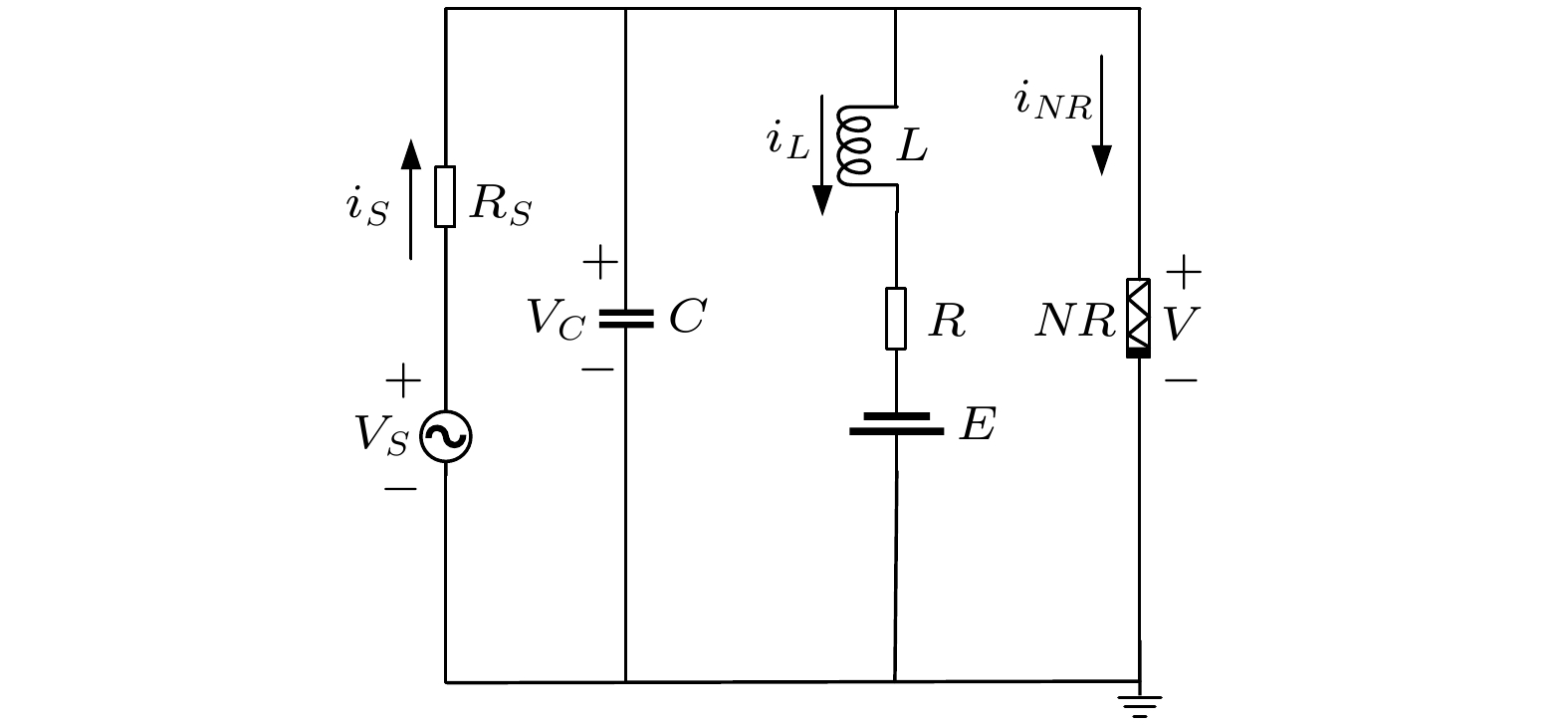
 下载:
下载:
